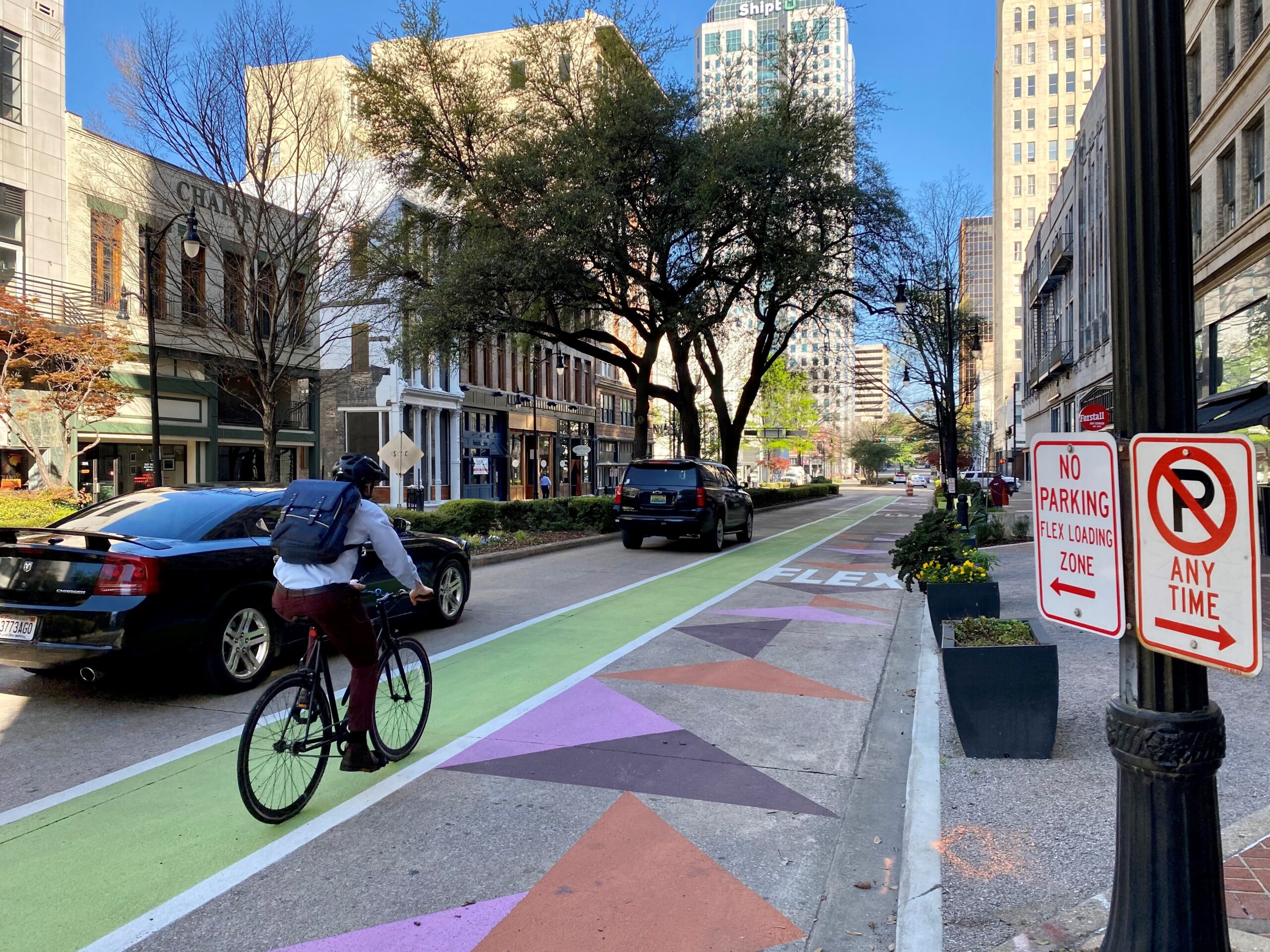
Flex lane paint is down on two blocks of 20th Street North, and we’re already hearing your celebration, thoughtful feedback, and a few questions!
If you haven’t seen the new look yet in person, plan a stroll soon down the Birmingham Green, then take our survey to tell us what you think about the usability and design of the flex lanes.
As we’ve been reviewing survey responses (yes, we’re reading them and taking it all in!), we’ve encountered several good questions, so we decided to address them in a short video tour. Take a look!
This design is based on national best practices and follows the direction of multiple City of Birmingham planning efforts, including the City Center Master Plan (2019), APPLE Study (2018), the Regional Planning Commission’s B Active Plan, and Birmingham’s Complete Streets Ordinance . All recognize a need for a safer and more multimodal downtown, especially along pedestrian corridors like 20th Street North.
The new design on 20th Street…
- creates a buffer from traffic for pedestrians on the sidewalk
- adapts to business needs like curbside food pickup, valet stands, and more creative uses
- gives bikes, scooters and other micromobility devices a well-defined space to travel in
- reduces the width of the travel lane, which is proven to reduce speeding, without changing the road’s capacity (meaning 20th can hold the same number of vehicles, but now they’re more likely to observe the speed limit)
Why is the bike lane in the middle?
Bike lanes that are separated from car traffic with parking space are awesome, but this flex lane is not parking. In addition to pick-up and loading/unloading, we expect more creative uses that will make the flex lane more like an extension of the sidewalk than a part of the road.
The bike lane’s position in the middle (rather than against the curb) also increases visibility between cyclists and drivers. Drivers turning right can easily spot cyclists, and cyclists making left turns can more easily merge left. The green of the bike lane is a standard color that drivers will see on bike lanes all over the country.
Where’s the bus stop?
Good catch – we moved it from a location where passengers had to board from a flower bed to the other side of the street where the bus can be boarded from the sidewalk! The bus stop is marked in red, which is the universal traffic paint color for public transportation.
Why those colors and shapes in the flex lane?
The flex lane is a bold new concept, so it needs a bold new design. The colors signal that this lane is different than normal parking or travel lanes. Plus, the colors can’t conflict with other traffic markings. Green bike lane, red bus stop, white and yellow lane striping: many colors have defined meanings on roadways. So the funky colors in the flex lanes are different by design.
The geometric pattern has a similar story. Alabama law prevents us from using a design that contains a representation of a real object, so no pictures or icons. Some geometric shapes and patterns are already spoken for as well, like the stripes of a crosswalk.
The design of the flex lane represents a new way of looking at streets in Birmingham. We’ve already seen that they can do so much more than host cars! While this exact design is specific to 20th Street, we look forward to testing it out here and applying the best concepts across the city to increase safety and vibrancy all over Birmingham. Can we get a #YayBham? 🙌
Related News
-
Safeguarding history, one preservation easement at a time
Filed Under: Developer, Front Page, Historic Preservation, Yaysayers
As longtime preservation advocates, we’re also proud to introduce REV’s own Historic Preservation Easement Program, created to help safeguard Birmingham’s irreplaceable architecture while adding long-term value to development projects involving historic properties.
-
Preservation that pays: How historic tax credits can power a downtown revival
Filed Under: Developer, Downtown Birmingham, Front Page, Historic Preservation
For preservation advocates (or “building huggers,” as we like to call ourselves), historic tax credits are essential. They don’t just help save historic buildings — they support local economies, encourage private investment and breathe new life into spaces that shape the identity of our communities.
-
Listing history, building legacy: The National Register’s role in downtown’s historic districts
Filed Under: Front Page, Historic Preservation
We’ve explored downtown Birmingham’s preservation wins and mourned its losses; this time, we’re turning our attention to the tools that help make preservation possible. In this piece, we’ll be diving into what is arguably the most foundational tool — and often the first step — in any preservation project: getting a building or district listed on the National Register of Historic Places.